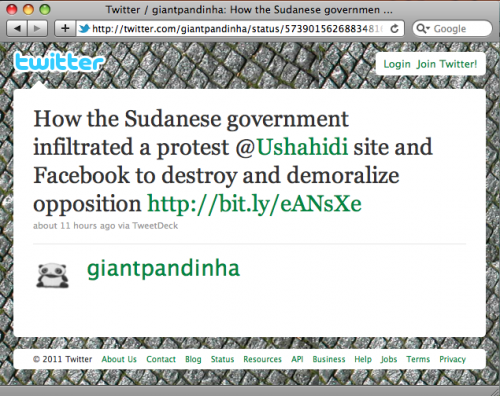Here we go again, but it's not what you think:
 Some colleagues and I worked on the Crowdmap that the Tweet above refers to. As mentioned in this previous post on the Ushahidi blog (from more than 3 months ago), the January 30th Sudan Crowdmap deployment was directly requested by local activists. The highly misleading Tweet above points to this article "How Sudan used the Internet to crush protest movement" which includes the following text:
Some colleagues and I worked on the Crowdmap that the Tweet above refers to. As mentioned in this previous post on the Ushahidi blog (from more than 3 months ago), the January 30th Sudan Crowdmap deployment was directly requested by local activists. The highly misleading Tweet above points to this article "How Sudan used the Internet to crush protest movement" which includes the following text:
 Some colleagues and I worked on the Crowdmap that the Tweet above refers to. As mentioned in this previous post on the Ushahidi blog (from more than 3 months ago), the January 30th Sudan Crowdmap deployment was directly requested by local activists. The highly misleading Tweet above points to this article "How Sudan used the Internet to crush protest movement" which includes the following text:
Some colleagues and I worked on the Crowdmap that the Tweet above refers to. As mentioned in this previous post on the Ushahidi blog (from more than 3 months ago), the January 30th Sudan Crowdmap deployment was directly requested by local activists. The highly misleading Tweet above points to this article "How Sudan used the Internet to crush protest movement" which includes the following text:
"Pro-government agents infiltrated anti-government sites, spreading disinformation and looking to triangulate the identities of the chief organizers. They'd barrage Facebook pages with pornography, then report the pages to Facebook for violating the rules. Protesters abandoned a website they'd launched to gather reports from the ground and map demonstrations online after they realized government agents were using the information. "Do not use SMS, and do not use the 'Submit a Report' link as these are currently not safe," the site now cautions. Combined with clever suppression tactics, the crackdown was highly effective."This is an example of journalism seeking to sensationalize how repressive regimes use technologies to clamp down on popular resistance movements. I should know, my doctoral dissertation (and visiting Fellowship at Stanford University) focuses on getting beyond the hype on exactly such issues. Indeed, my two case studies focus on the use of the Ushahidi platform in both Sudan and Egypt. So first of all, the above excerpt is misleading. The sequencing in the text implies that pro-government agents infiltrated the Crowdmap which is completely false. Furthermore, the website was not abandoned. We simply phased out the mapping after the first wave of protests were over, that's all. There is a "Contact" form on that Crowdmap deployment. The least the journalist could have done was send along some questions. Second of all, of course we wrote those cautionary words "do no use SMS" and "do not use Submit a Report" because using SMS and unencrypted webforms may not be safe in such situations. Sudanese protestors had insisted on having an SMS number because it was easier for them to coordinate over SMS than online. So we piloted an SMS long code for just 24 hours and then decided to scrap it because there was simply no guarantee that the Sudanese government was not tracking SMS traffic. We did not scrap SMS reporting because the map had gotten compromised, it was simply pre-emptive on our part as we decided to err on the side of caution. The SMS number was never advertised on any other website including Facebook and we actually never received any SMS reports anyway. Third, after this Sudan Crowdmap deployment, my colleagues and I published the lessons learned from the project in a blog post on "The Security and Ethics of Live Mapping in Repressive Regimes and Hostile Environments." We also shared this with the Crisis Mappers Network for feedback. There is absolutely no doubt (or hardly any surprises) that crisis mapping in repressive environments poses some serious challenges. This is why one of the two main panels at the 2010 International Conference on Crisis Mapping (ICCM 2010) included expert panelists to address these very real issues. Fourth, there absolutely are important limitations to the use of crisis mapping platforms in non-permissive environments, and this certainly includes the Ushahidi platform. That is why we have been actively collaborating with a number of groups to carry out a security audit and upgrade of the platform. In the meantime, the "Security and Ethics" blog posts includes important guidelines for crisis mapping in repressive environments. We certainly don't have all the answers and as always welcome input from our community and beyond. But when activists do approach us about using our technology in an environment that we feel is dangerous, we are very upfront about this and make sure to outline the risks very clearly.